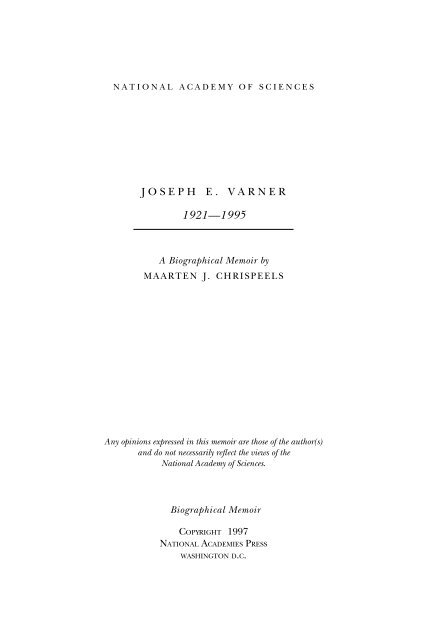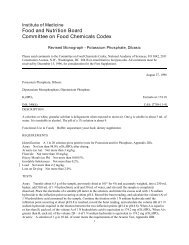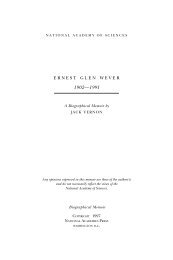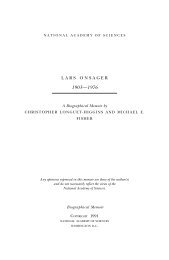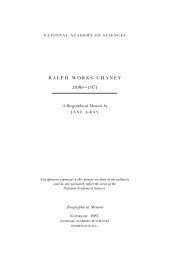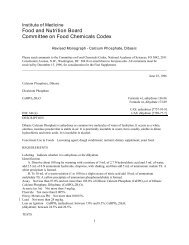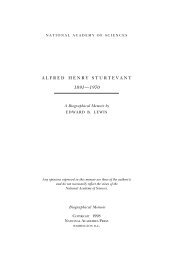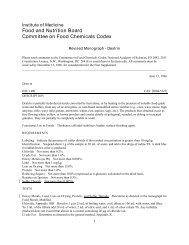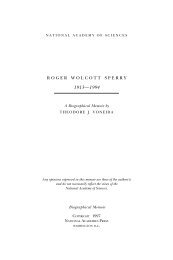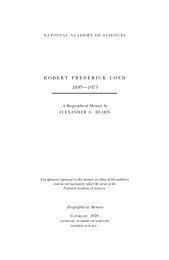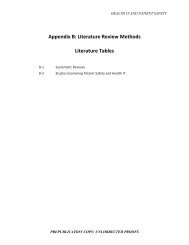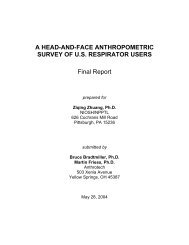JOSEPH E. VARNER - National Academy of Sciences
JOSEPH E. VARNER - National Academy of Sciences
JOSEPH E. VARNER - National Academy of Sciences
Create successful ePaper yourself
Turn your PDF publications into a flip-book with our unique Google optimized e-Paper software.
n a t i o n a l a c a d e m y o f s c i e n c e s<br />
J o s e p h E . V a r n e r<br />
1921—1995<br />
A Biographical Memoir by<br />
M a a r t e n J . C h r i s p e e l s<br />
Any opinions expressed in this memoir are those <strong>of</strong> the author(s)<br />
and do not necessarily reflect the views <strong>of</strong> the<br />
<strong>National</strong> <strong>Academy</strong> <strong>of</strong> <strong>Sciences</strong>.<br />
Biographical Memoir<br />
Copyright 1997<br />
<strong>National</strong> Academies Press<br />
washington d.c.
<strong>JOSEPH</strong> E. <strong>VARNER</strong><br />
October 7, 1921–July 4, 1995<br />
BY MAARTEN J. CHRISPEELS<br />
J<br />
OSEPH E. <strong>VARNER</strong>’S fifty-year career (1945-95) spanned the<br />
emergence and development <strong>of</strong> plant biochemistry, and<br />
he was one <strong>of</strong> the major contributors to this field. His most<br />
notable research achievements were the definition <strong>of</strong> cell<br />
death as an active process; discovery that the hormone gibberellin<br />
regulates the expression <strong>of</strong> α-amylase in barley aleurone<br />
cells at the level <strong>of</strong> the gene; and cloning <strong>of</strong> the cDNA<br />
for the cell wall protein extensin, which laid the foundation<br />
for the study <strong>of</strong> the role <strong>of</strong> cell wall proteins in plants.<br />
Together with James Bonner, Varner edited Plant Biochemistry,<br />
which remained the standard single-volume textbook in<br />
the field for fifteen years. During the last ten years <strong>of</strong> his<br />
life he was probably the most widely admired and loved<br />
plant biologist in the country, the elder statesman <strong>of</strong> his<br />
discipline. He was extremely knowledgeable about biochemistry<br />
and whenever he talked to colleagues or students he<br />
generously shared his many ideas. He was a tireless promoter<br />
<strong>of</strong> the study <strong>of</strong> plants and talked about experiments<br />
until the final days <strong>of</strong> his life. In addition, Varner was a<br />
sought-after advisor to government, universities, and industry.<br />
He was a major supporter <strong>of</strong> the American Society <strong>of</strong><br />
Plant Physiologists, which he served as president in 1970-71<br />
353
354 BIOGRAPHICAL MEMOIRS<br />
and which awarded him its highest honor, the Stephen Hales<br />
Prize, in 1990.<br />
GROWING UP IN OHIO AND STARTING A FAMILY<br />
Joe Varner was born and grew up in Nashport, Ohio, on<br />
a farm that had been in the family’s possession for several<br />
generations. He was the second <strong>of</strong> four sons, one <strong>of</strong> whom<br />
(Robert Varner) carried on the farming tradition; thus, Joe<br />
Varner always maintained his ties to the land. His parents,<br />
George and Inez Gladden Varner, were both school teachers,<br />
and the Varner children were educated first in the rural<br />
one-room schoolhouse where their father was the teacher.<br />
They later attended the local high school. Inez Varner stayed<br />
home to help run the farm and care for her family. Joe’s<br />
love <strong>of</strong> science was apparent early on and he won an award<br />
for “best student in the county in chemistry and physics.”<br />
He continued his education at Ohio State University (OSU),<br />
where he majored in chemistry and received a bachelor’s<br />
degree in 1942 and a master’s degree in 1943. About his<br />
education at OSU he wrote, “It was possible to earn a B.Sc.<br />
in chemistry without hearing a single word about physiological<br />
chemistry or photosynthesis. It was also possible to<br />
sit through an entire year <strong>of</strong> elementary botany without<br />
hearing a single instance <strong>of</strong> how a chemist might make a<br />
contribution to botany.”<br />
Joe joined the U.S. Marine Corps in 1944, and while he<br />
was in the service he found a book on physiological chemistry<br />
(Hawk, Oser, and Summerson) at the Santa Ana Public<br />
Library that opened his eyes to new possibilities for research.<br />
“Wouldn’t it be nice to do that sort <strong>of</strong> thing with<br />
plants,” thought Varner. In 1945 Joe married Carol (“Ray”)<br />
Dewey and together they raised a family consisting <strong>of</strong> son<br />
Lee and daughters Lynn, Karen, and Beth. Joe was first<br />
employed as an analytical chemist by the Battelle Memorial
<strong>JOSEPH</strong> E. <strong>VARNER</strong><br />
355<br />
Institute, but after a year he returned to OSU to work on<br />
his doctorate supported by the G.I. Bill. He wanted to know<br />
“how plants work” rather than “what they are made <strong>of</strong>,” and<br />
he was awarded a Ph.D. in biochemistry in 1949.<br />
THE FIRST TEN YEARS: FROM ORGANIC ACIDS<br />
TO ENZYME SYNTHESIS<br />
Varner started his career when plant biochemistry was<br />
emerging as a new branch <strong>of</strong> experimental plant biology.<br />
At that time plant physiology concerned itself with mineral<br />
nutrition <strong>of</strong> plants, the environmental stimuli that induce<br />
plants to flower, and the idea that hormones control plant<br />
development. The availability <strong>of</strong> radioactive CO 2<br />
led to the<br />
study <strong>of</strong> plant metabolism and in the late 1940s and early<br />
1950s understanding metabolism was seen as an important<br />
step in elucidating the control <strong>of</strong> plant growth and development.<br />
Varner’s doctoral dissertation, carried out under the guidance<br />
<strong>of</strong> Pr<strong>of</strong>. Robin C. Burrell and presented in 1949, dealt<br />
with the metabolism <strong>of</strong> organic acids in Bryophyllum calycinum,<br />
a plant that fixes carbon dioxide into malic acid during the<br />
night, then breaks down the malic acid again during the<br />
day to re-fix the released CO 2<br />
with ribulose bisphosphate<br />
oxygenase. For this study Varner used radioactive CO 2<br />
supplied<br />
by the Oak Ridge <strong>National</strong> Laboratory. No one at<br />
OSU had any experience with 14 C, so Joe used his own<br />
money to go to Oak Ridge for a thirty-day training course<br />
in radioisotopes. Later in his career he would continue to<br />
use isotopes in very clever ways.<br />
During his first three years as an assistant pr<strong>of</strong>essor <strong>of</strong><br />
biochemistry at OSU, where he was appointed to the faculty<br />
in 1950, Varner continued to work on organic acids<br />
and he developed a method for their separation by chromatography.<br />
However, after spending a year (1953-54) at
356 BIOGRAPHICAL MEMOIRS<br />
the California Institute <strong>of</strong> Technology in the laboratory <strong>of</strong><br />
James Bonner, Varner changed his research direction quite<br />
dramatically. In the 1950s Caltech was a hot place for plant<br />
biology with three active laboratories, those <strong>of</strong> James Bonner,<br />
Arthur Galston, and Frits Went. James Bonner’s laboratory<br />
was a magnet for plant biochemistry with graduate students<br />
and postdocs, such as Sam Wildman, George Laties, Bernard<br />
Axelrod, Robert Bandurski, George Webster, and many<br />
others who went on to make major contributions to this<br />
new field. By all accounts the research environment was<br />
enormously stimulating. Ideas flowed freely between genetic,<br />
structural, and biochemical laboratories, and the sky seemed<br />
the limit. The young scientists could hardly wait to answer<br />
all <strong>of</strong> plant biology’s pressing questions. The year at Caltech<br />
had a pr<strong>of</strong>ound impact on Varner’s career, and his lifelong<br />
friendship with James Bonner resulted in the joint editing<br />
<strong>of</strong> Plant Biochemistry.<br />
After returning to OSU from his sabbatical at Caltech,<br />
Varner convinced George Webster to join him there. Together<br />
they started working on the biosynthesis <strong>of</strong> glutamine,<br />
asparagine, and glutathione. They saw the tripeptide glutathione<br />
as a simple model to study peptide synthesis. This<br />
work is evidence <strong>of</strong> Varner’s desire to get beyond metabolism<br />
and to look at how processes in living organisms are<br />
controlled. When Varner arrived at Caltech, Watson and<br />
Crick had just published their model <strong>of</strong> the structure <strong>of</strong><br />
DNA, and soon after he returned to OSU different laboratories<br />
started reporting that proteins could be synthesized<br />
in vitro. Furthermore, the one-gene-one-enzyme theory <strong>of</strong><br />
Beadle and Tatum was much talked about, although the<br />
discovery <strong>of</strong> mRNA, the connection between DNA and protein,<br />
was still ten years away. The work on glutathione biosynthesis<br />
was important in its own right, but it did not lead
<strong>JOSEPH</strong> E. <strong>VARNER</strong><br />
357<br />
to a better understanding <strong>of</strong> protein synthesis, because no<br />
mRNA template is required to order the amino acids.<br />
Webster went on to work on in vitro protein synthesis,<br />
but Varner turned his attention to the role <strong>of</strong> oxidative<br />
phosphorylation and protein synthesis in development (fruit<br />
ripening) and senescence (pea cotyledons). His main contribution<br />
here was to define cell death as an active process<br />
that requires respiration and the synthesis <strong>of</strong> new enzymes.<br />
His work on the synthesis <strong>of</strong> enzymes in pea cotyledons<br />
during seedling growth followed closely on the heels <strong>of</strong><br />
work by Harry Beevers who demonstrated the induction <strong>of</strong><br />
glyoxylate cycle enzymes in castor bean endosperm, another<br />
senescing tissue. In 1961 Varner published “Senescence in<br />
plants,” a major review on this topic in the Annual Review <strong>of</strong><br />
Plant Physiology. In the Plant Biochemistry textbook, edited<br />
with James Bonner in 1965, he devoted an entire chapter<br />
to “death.” Those who recently “discovered” apoptosis in<br />
plants can pr<strong>of</strong>it from reading it. Subsequently, Varner’s<br />
lab found that a diffusible factor from the axis regulates<br />
cotyledon senescence.<br />
At this time Varner was also working on oxygen exchange<br />
reactions. He investigated the transfer <strong>of</strong> oxygen from 18 O-<br />
labeled arsenate in the arsenolysis <strong>of</strong> glutamine. Throughout<br />
his career Varner used isotopes in many creative ways,<br />
not only for metabolic labeling but also for exchange reactions,<br />
density labeling, protein turnover, and in planta enzyme<br />
assays. Joe’s older brother David was a successful inventor,<br />
and Joe had a touch <strong>of</strong> the same creative streak. In<br />
1952 he published a paper entitled “An automatic constant<br />
volume fraction collector” in the Journal <strong>of</strong> Chemical Education.
358 BIOGRAPHICAL MEMOIRS<br />
CAMBRIDGE UNIVERSITY AND THE RESEARCH INSTITUTE FOR<br />
ADVANCED STUDIES<br />
In 1959 Joe took his family to England for a sabbatical<br />
leave at Cambridge University. After returning to Columbus<br />
he became dissatisfied at OSU. He told the dean he was<br />
underpaid and unappreciated (Varner apparently had not<br />
yet been promoted to associate pr<strong>of</strong>essor). The dean replied<br />
that if Varner thought he was worth more money, he<br />
should find an employer willing to pay more. By his own<br />
account, Varner promptly wrote a letter <strong>of</strong> resignation and<br />
somewhat later found a position with the Research Institute<br />
for Advanced Studies (RIAS), a division <strong>of</strong> the Martin Marietta<br />
Corporation. RIAS was housed in a large suburban property<br />
in Baltimore and consisted <strong>of</strong> a small community <strong>of</strong><br />
physicists, chemists, mathematicians, and a few biologists.<br />
The biology group was led by Bessel Kok, a feisty, brilliant<br />
Dutchman (later elected to the <strong>National</strong> <strong>Academy</strong> <strong>of</strong> <strong>Sciences</strong>),<br />
who, like Bonner, had a pr<strong>of</strong>ound impact on Varner’s<br />
career. RIAS housed a lively group <strong>of</strong> scholars; ideas and<br />
experiments were hotly debated in the cafeteria and at social<br />
gatherings. Kok and Varner, along with George Cheniae<br />
and Dick Radmer, constituted a true debating society. Varner’s<br />
critical thinking skills were sharpened by these lively exchanges.<br />
During four productive years at RIAS, Varner poured<br />
his creativity into two scientific problems: hormonal control<br />
<strong>of</strong> enzyme synthesis (see below) and the detection <strong>of</strong><br />
life on Mars. The work on the detection <strong>of</strong> life on Mars was<br />
triggered by a call for proposals from NASA to design a 10-<br />
lb instrument that could detect “life” (not just life as we<br />
know it). With his background in chemistry and his interest<br />
in exchange reactions Varner argued persuasively that we<br />
should not look for metabolism (e.g., CO 2<br />
assimilation or<br />
release), but rather measure exchange reactions. About this
<strong>JOSEPH</strong> E. <strong>VARNER</strong><br />
359<br />
time it was discovered that phosphoryl/phosphate group<br />
transfers resulted in H 2 18 O formation when 18 O-phosphatelabeled<br />
substrates were used, and Varner suggested that such<br />
exchange between water and oxy-anions (phosphate, sulfate,<br />
nitrate) could possibly constitute the simplest reactions<br />
<strong>of</strong> “life,” whether on Earth or elsewhere. These ideas<br />
were published in an article in Science in 1967, but the probe<br />
that was eventually built (but not used because <strong>of</strong> NASA<br />
budget constraints) relied on the “sniffing” <strong>of</strong> gases and<br />
their analysis by a 10-lb mass spectrometer.<br />
HORMONAL CONTROL OF ENZYME SYNTHESIS<br />
The research for which Varner is best known was his demonstration<br />
that the plant hormone gibberellin induces cereal<br />
aleurone cells to synthesize massive amounts <strong>of</strong> α-amylase<br />
through the action <strong>of</strong> the hormone on gene activity. I<br />
had the good fortune to join this project as a postdoc in his<br />
laboratory. This work finds its origins in the independent<br />
observations by L. G. Paleg and H. Yomo that addition <strong>of</strong><br />
gibberellin to barley grains, from which the embryo had<br />
been removed, greatly enhanced the release <strong>of</strong> sugars and<br />
the production <strong>of</strong> amylolytic enzymes. Varner, who was fully<br />
conversant with recent developments in molecular biology,<br />
suspected that gibberellin was inducing α-amylase release<br />
(activation or synthesis) probably by a process <strong>of</strong> gene activation.<br />
He quickly adopted the barley endosperm system as<br />
a model to study the genetic basis <strong>of</strong> hormonal control <strong>of</strong><br />
enzyme synthesis, and in 1964 he published a seminal paper<br />
on this topic in the Proceedings <strong>of</strong> the <strong>National</strong> <strong>Academy</strong> <strong>of</strong><br />
<strong>Sciences</strong> (the paper was communicated by James Bonner).<br />
Using the available tools, inhibitors <strong>of</strong> protein synthesis<br />
(amino acid analogs) and RNA synthesis (actinomycin D),<br />
he was able to conclude that “the effect <strong>of</strong> gibberellic acid<br />
is therefore upon the expression <strong>of</strong> the genetic informa-
360 BIOGRAPHICAL MEMOIRS<br />
tion which controls α-amylase production.” The paper also<br />
demonstrated that incubation <strong>of</strong> endosperm tissue with radioactive<br />
amino acids resulted in the production <strong>of</strong> radioactive<br />
α-amylase, suggesting de novo synthesis <strong>of</strong> the enzyme.<br />
A major point <strong>of</strong> discussion at the time was whether<br />
the appearance <strong>of</strong> enzyme activity in storage organs <strong>of</strong> seeds<br />
during seedling growth resulted from the activation <strong>of</strong> an<br />
inactive enzyme precursor (zymogen) or from de novo synthesis<br />
<strong>of</strong> the enzyme.<br />
This elegant work, which was initiated at RIAS in Baltimore,<br />
drew the attention <strong>of</strong> more classically oriented plant<br />
physiologists such as Anton Lang, who had just been named<br />
director <strong>of</strong> the newly created Atomic Energy Commission<br />
Plant Research Laboratory at Michigan State University<br />
(MSU), and Lang <strong>of</strong>fered Varner a position at MSU. Varner<br />
left RIAS in the spring <strong>of</strong> 1965, and much <strong>of</strong> the work on<br />
the barley system was done in the next eight years at MSU<br />
by his graduate students (U. Melcher, W. Evins, and D. C.<br />
Koehler) and postdocs (J. V. Jacobsen, G. R. Chandra, and<br />
myself). Nevertheless, it was ten years before David Ho,<br />
another Ph.D. student, showed that gibberellin induces the<br />
synthesis <strong>of</strong> α-amylase mRNA, primarily because the molecular<br />
tools to answer that question were not available until<br />
then.<br />
Varner combined his penchant for devising simple yet<br />
elegant techniques and his love affair with isotopically labeled<br />
metabolites to measure, in collaboration with Philip<br />
Filner, protein synthesis using density labeling. They used<br />
heavy water (H 2 18 O) to demonstrate that the increase in α-<br />
amylase activity induced by gibberellin in aleurone layers<br />
was due to de novo synthesis <strong>of</strong> the enzyme. Varner reasoned<br />
that the 18 O would be incorporated into amino acids<br />
during hydrolysis <strong>of</strong> the reserve proteins <strong>of</strong> the endosperm<br />
and would then appear in all newly synthesized proteins.
<strong>JOSEPH</strong> E. <strong>VARNER</strong><br />
361<br />
Newly synthesized proteins should, therefore, have a greater<br />
density than did pre-existing proteins, and the technique<br />
would settle the zymogen activation question. The proteins<br />
were fractionated on isopycnic CsCl gradients in an adaptation<br />
<strong>of</strong> the Meselson-Stahl experiment demonstrating the<br />
semi-conservative replication <strong>of</strong> DNA; the average density<br />
<strong>of</strong> α-amylase synthesized in the presence <strong>of</strong> 80% H 2 18 O was<br />
found to be 1.1% greater than that <strong>of</strong> the enzyme synthesized<br />
in the presence <strong>of</strong> H 2 16 O. The whole experiment was<br />
conducted with two aleurone layers and 100 µ1 <strong>of</strong> water!<br />
The so-called density labeling technique was widely applied<br />
in many plant biochemistry laboratories to demonstrate de<br />
novo enzyme synthesis. However, because <strong>of</strong> the expense <strong>of</strong><br />
H 2 18 O, D 2<br />
O was used for most experiments.<br />
Gibberellin not only turns on the expression <strong>of</strong> the genes<br />
for α-amylase (and other hydrolytic enzymes) in aleurone<br />
cells, but also induces the formation <strong>of</strong> the endoplasmic<br />
reticulum, the site <strong>of</strong> synthesis <strong>of</strong> these secreted enzymes.<br />
Plant cells were known to possess is<strong>of</strong>orms <strong>of</strong> enzymes that<br />
remain inside the cell, as well as is<strong>of</strong>orms that are secreted.<br />
Varner coined the terms “inzymes” and “outzymes” for such<br />
is<strong>of</strong>orms and discussed with his associates at length his idea<br />
that there must be subtle differences in protein structure<br />
between the two that allow them to be routed to these two<br />
different destinations. We now call these structural differences<br />
“targeting signals.” My Ph.D. thesis in the laboratory<br />
<strong>of</strong> John Hanson at the University <strong>of</strong> Illinois on changes in<br />
microsomes during cell elongation and my postdoctoral research<br />
in Varner’s laboratory on α-amylase secretion led to<br />
a career in plant cell biology and a study <strong>of</strong> protein targeting<br />
signals and the role <strong>of</strong> the Golgi apparatus in glycosylation.<br />
Varner remained interested in secretion, and in 1971-72 he<br />
took a sabbatical leave at the University <strong>of</strong> Washington to<br />
become more familiar with yeast (Saccharomyces cerevisiae)
362 BIOGRAPHICAL MEMOIRS<br />
because he thought that it might be a more suitable system<br />
for studying this process.<br />
In 1973 Varner left the Plant Research Laboratory and<br />
moved to the Biology Department <strong>of</strong> Washington University<br />
in St. Louis. At Washington University he started with a<br />
small research group, but he had plans for his new department.<br />
Soon after arriving in St. Louis, he convinced the<br />
then chancellor William Danforth that he could build a<br />
first-rate plant biology program if the department were given<br />
additional faculty positions. Varner clearly saw that plant<br />
biology was nearing a new take<strong>of</strong>f point and he wanted<br />
Washington University to be part <strong>of</strong> it. He attracted a number<br />
<strong>of</strong> first-rate junior plant biologists to the department,<br />
including Roger Beachy, Mary Dell Chilton, William Outlaw,<br />
and Virginia Walbot. Subsequently, additional plant biologists<br />
joined this group. Soon after coming to St. Louis,<br />
Varner met Jane E. Burton and in 1976 they were married.<br />
They spent twenty happy years together, and he was a caring<br />
stepfather for her two children. Scores <strong>of</strong> plant biologists<br />
from all over the world enjoyed the hospitality Joe and<br />
Janie provided in their lovely home on Kingsbury Avenue.<br />
At Washington University he carried on with the work on<br />
gibberellin and aleurone cells for a few years and started<br />
his research on cell wall proteins and cell wall architecture.<br />
HYDROXYPROLINE-RICH GLYCOPROTEINS AND EXTENSIN<br />
While on sabbatical leave at Cambridge University, Varner<br />
met Derek Lamport who was then a Ph.D. student <strong>of</strong> D. H.<br />
Northcote. Lamport had just discovered that the most abundant<br />
amino acid in a hydrolysate <strong>of</strong> purified sycamore cell<br />
walls was hydroxyproline and had postulated that the cell<br />
wall contained a structural protein, which he called extensin.<br />
Varner was fascinated by the idea and invited Lamport to<br />
become an independent postdoc in his laboratory at RIAS.
<strong>JOSEPH</strong> E. <strong>VARNER</strong><br />
363<br />
Later, he persuaded Anton Lang to appoint Lamport an<br />
assistant pr<strong>of</strong>essor at the AEC Plant Research Laboratory,<br />
where they both moved in 1965. While at MSU, Varner and<br />
Lamport worked in adjacent laboratories and interacted on<br />
a daily basis. Lamport continued the biochemical characterization<br />
<strong>of</strong> extensin, proving its existence to early skeptics.<br />
After Varner moved to Washington University he sensed<br />
that aleurone layers and gibberellic acid had run their<br />
courses, at least in his laboratories, and after some hesitation<br />
he moved to the cell wall protein problem. The hesitation<br />
probably stemmed from a reluctance to compete with<br />
his long-time friend. However, he knew better than anyone<br />
else that Lamport was too set in his biochemical ways to<br />
utilize the new molecular tools to push the analysis <strong>of</strong> extensin<br />
into new terrain. Varner’s lab used two approaches to get at<br />
the extensin protein: the purification <strong>of</strong> a precursor protein<br />
before it becomes covalently linked to the cell wall<br />
matrix and the cloning <strong>of</strong> a cDNA. He switched to the aerated<br />
carrot disk system used in my laboratory because we<br />
had shown in the late 1960s that wounding (when the disks<br />
are cut) induces massive synthesis <strong>of</strong> hydroxyproline-rich<br />
glycoproteins (HRGP, Varner’s new term for extensin). They<br />
made several attempts to obtain the extensin cDNA. Realizing<br />
that a Hyp-rich protein should have a cytosine-rich message,<br />
David Stuart attempted to use polyG columns to isolate<br />
the message using in vitro incorporation <strong>of</strong> amino acids.<br />
They also devised a way to identify clones that have prolinerich<br />
and leucine-poor translation products. These approaches<br />
failed, and the cDNA clone for extensin was finally obtained<br />
through a library screen by Jychian Chen, a graduate student<br />
from Taiwan.<br />
The findings were published in the Proceedings <strong>of</strong> the <strong>National</strong><br />
<strong>Academy</strong> <strong>of</strong> <strong>Sciences</strong> and were communicated by Varner
364 BIOGRAPHICAL MEMOIRS<br />
himself, having been elected to membership in the <strong>Academy</strong><br />
in 1984. They confirmed the work <strong>of</strong> Lamport and<br />
showed that the pentapeptide Ser(Pro) 4<br />
was repeated 25<br />
times in the derived amino acid sequence <strong>of</strong> 306 amino<br />
acids. TyrLysTyrLys and ThrProVal were also found as other<br />
major repeating units. This first cloning <strong>of</strong> extensin opened<br />
up the whole field <strong>of</strong> cell wall structural proteins. Other<br />
students and postdocs worked on many different aspects <strong>of</strong><br />
HRGP biosynthesis, including insolubilization in the wall,<br />
structure <strong>of</strong> the protein, and the induction by pathogens.<br />
With Gladys Cassab, a Ph.D. student from Mexico, he described<br />
an entirely new glycine-rich cell wall protein, which<br />
he referred to as plant silk. As a result <strong>of</strong> these important<br />
contributions Varner was asked to write a review on cell<br />
wall architecture for Cell.<br />
While in St. Louis, Varner became a consultant for<br />
Monsanto and initiated a joint research project with Jake<br />
Schaeffer and others to investigate nitrogen metabolism<br />
(glycine and asparagine utilization and protein turnover)<br />
in soybean using 15 N and 13 C NMR. Again, he cleverly used<br />
isotopically labeled metabolites, this time coupled to a hightech<br />
analytical technique.<br />
In 1977, in recognition <strong>of</strong> Joe’s numerous contributions<br />
to plant biochemistry, the University <strong>of</strong> Nancy awarded him<br />
a doctor honoris causa degree. Together with Jane he traveled<br />
to France and enjoyed the French hospitality.<br />
TISSUE PRINTING, LIGNIN BIOSYNTHESIS AND<br />
CELL DEATH (REPRISE)<br />
As noted earlier, Varner had a penchant for simple yet<br />
elegant techniques designed to answer interesting questions.<br />
In 1986, with Gladys Cassab, he revived the technique <strong>of</strong><br />
tissue printing. The question they wanted to answer was<br />
whether cell walls <strong>of</strong> different cell types differ in their mac-
<strong>JOSEPH</strong> E. <strong>VARNER</strong><br />
365<br />
romolecular constituents. If mesophyll cells and bundle sheath<br />
cells have different cytoplasmic structures, do they also have<br />
different cell walls? Tissue printing had been used <strong>of</strong>f and<br />
on to detect enzymes on substrate films (e.g., gelatin), but<br />
Varner turned to the nitrocellulose sheets already in common<br />
use for immunoblotting to make tissue prints. When a<br />
thin tissue slice, especially from a stem, is pressed against<br />
nitrocellulose paper, the hard cell walls make a slight indentation,<br />
and the proteins that are not covalently bound<br />
to the wall are transferred to the nitrocellulose (as are the<br />
cytoplasmic proteins). The proteins can then be detected<br />
by relying on their enzymatic activity (e.g., peroxidase) or<br />
with antibodies (as with immunoblotting). Using side illumination<br />
and a low-power light microscope, Varner obtained<br />
amazingly beautiful images. Getting good results is not as<br />
easy as it sounds, but Varner and a few <strong>of</strong> his students (Gladys<br />
Cassab and Rosannah Taylor) became experts and published<br />
several articles demonstrating the utility <strong>of</strong> the technique<br />
in showing cell wall differentiation.<br />
Around 1990, when Zeng-hua Ye came to his laboratory,<br />
Varner combined his interest in cell wall architecture with<br />
a much older interest in programmed cell death. Together<br />
they started working on lignin biosynthesis in differentiating<br />
xylem elements <strong>of</strong> cultured Zinnia elegans mesophyll<br />
cells. With this cell system, developed in Japan by H. Fukuda<br />
and A. Komamine, they studied O-methyltransferases in<br />
xylogenesis. Their intention was to use the tools <strong>of</strong> molecular<br />
biology to unravel this intriguing developmental program<br />
in which the cell first elaborates a complex cell wall<br />
and becomes fully functional in water transport after it dies.<br />
MENTORING<br />
Joe Varner was an unusually effective mentor <strong>of</strong> young<br />
scientists. He was the advisor for three masters students,
366 BIOGRAPHICAL MEMOIRS<br />
seventeen doctoral students, and forty-six postdocs and sabbatical<br />
visitors. His influence was felt beyond his own laboratory<br />
because the impromptu scientific discussions around<br />
the c<strong>of</strong>fee table or at lunch attracted graduate students and<br />
postdocs from many other laboratories. Together they would<br />
dissect a scientific question and illuminate it from different<br />
angles. How can enzymology, cell biology, biophysics, chemistry,<br />
and structural biology help us get an answer? His favorite<br />
term was “brain candy,” the reward the brain gets for<br />
thinking up clever solutions to difficult problems. At a symposium<br />
held in Varner’s honor at the time <strong>of</strong> his retirement<br />
in 1993 the many participants referred to the influence<br />
that Varner’s ideas—his brain candy—had on their<br />
research.<br />
PUBLIC SERVICE<br />
Throughout his career Varner was a sought-after advisor<br />
who contributed substantially to government, industry, and<br />
academic advisory groups. He was a member <strong>of</strong> the <strong>National</strong><br />
Science Foundation’s Developmental Biology Panel<br />
(1968-71) and the Genetic Mechanisms for Crop Improvement<br />
Panel <strong>of</strong> the U.S. Department <strong>of</strong> Agriculture (CRGO)<br />
(1982-85). Realizing the importance <strong>of</strong> the Department <strong>of</strong><br />
Agriculture’s competitive research grant organization, he<br />
volunteered to serve as a program manager (1984-85) and<br />
as chief scientist (1986-87). In this last capacity he persuaded<br />
the Department <strong>of</strong> Agriculture to start a postdoctoral grant<br />
program. He served as chair <strong>of</strong> the Scientific Council <strong>of</strong><br />
the Plant Gene Expression Center <strong>of</strong> the Department <strong>of</strong><br />
Agriculture’s Agricultural Research Service in Albany, California<br />
(1985-90), and was on the visiting committee <strong>of</strong> the<br />
Department <strong>of</strong> Plant Biology at the Carnegie Institution <strong>of</strong><br />
Washington in Palo Alto, California (1981-86). For sixteen<br />
years he was an associate editor <strong>of</strong> Plant Physiology (1967-84)
<strong>JOSEPH</strong> E. <strong>VARNER</strong><br />
367<br />
and for five years served on the editorial board <strong>of</strong> the Annual<br />
Review <strong>of</strong> Plant Physiology 1970-75). He was sought for<br />
these positions because <strong>of</strong> his renown for fairness and absolute<br />
integrity. The betterment <strong>of</strong> plant biology was his only<br />
agenda.<br />
Varner was an engaging lecturer who on eight occasions<br />
took a month from his busy schedule to give an upper division/graduate<br />
course in plant biochemistry at other universities,<br />
including the <strong>National</strong> Taiwan University (1960), <strong>National</strong><br />
University <strong>of</strong> Mexico (1976), University <strong>of</strong> California,<br />
Riverside (1978 and 1982), University <strong>of</strong> California, San<br />
Diego (1979), University <strong>of</strong> Chile (1981 and 1983), and<br />
North Carolina State University (1984). I had the good fortune<br />
to attend the 1979 course at San Diego. Several hours<br />
<strong>of</strong> reading and preparation went into each lecture and the<br />
chemical basis <strong>of</strong> all phenomena was explored in depth.<br />
During these extended visits he always took the time to<br />
share his extensive biochemical knowledge with his colleagues.<br />
In the late 1980s he became concerned that plant biochemistry<br />
was being neglected. “Soon, every graduate student<br />
will know how to clone a gene, but no one will know<br />
how to investigate function” was his rationale for approaching<br />
the granting agencies for support for a national plant<br />
biochemistry course. The course has been held annually in<br />
different locations and has attracted students from everywhere.<br />
Varner’s death from cancer at the age <strong>of</strong> seventy-four was<br />
an enormous loss for plant biology. An excellent and generous<br />
scientist, he was universally admired by his colleagues.<br />
He was a tireless promoter and spokesman for his discipline<br />
and a mentor and friend to many, especially the young.
368 BIOGRAPHICAL MEMOIRS<br />
THE FOLLOWING PEOPLE HELPED me by providing details or reading the<br />
finished manuscript: Roger Beachy, Jane Burton, Joe Chappell, James<br />
Cooper, George Cheniae, Jack Hanson, David Ho, Hans Kende,<br />
Frank Salisbury, and Paul Saltman.
<strong>JOSEPH</strong> E. <strong>VARNER</strong><br />
369<br />
SELECTED BIBLIOGRAPHY<br />
1950<br />
With R. C. Burrell. Use <strong>of</strong> C 14 in the study <strong>of</strong> the acid metabolism<br />
<strong>of</strong> Bryophyllum calycinum. Arch. Biochem. 25:280.<br />
1955<br />
With G. C. Webster. Peptide bond synthesis in higher plants. III.<br />
The formation <strong>of</strong> glutathione from g-glutamylcysteine. Arch. Biochem.<br />
Biophys. 55:95-103.<br />
1957<br />
With J. D. Marks and R. Bernlohr. Esterification <strong>of</strong> phosphate in<br />
ripening fruit. Plant Physiol. 32:259.<br />
1958<br />
With D. H. Slocum and G. C. Webster. Transfer <strong>of</strong> oxygen in the<br />
arsenolysis <strong>of</strong> glutamine. Arch. Biochem. 73:508.<br />
1960<br />
With J. L. Young, R. C. Huang, S. Vanecko, and J. D. Marks. Conditions<br />
affecting enzyme synthesis in the cotyledons <strong>of</strong> germinating<br />
seeds. Plant Physiol. 35:288.<br />
1961<br />
Senescence in plants. Annu. Rev. Plant Physiol. 12:245.<br />
1964<br />
With G. R. Chandra. Hormonal control <strong>of</strong> enzyme synthesis in barley<br />
endosperm. Proc. Natl. Acad. Sci. U.S.A. 52:100-106.<br />
1965<br />
With G. R. Chandra. Gibberellic acid controlled metabolism <strong>of</strong> RNA<br />
in aleurone cells <strong>of</strong> barley. Biochem. Biophys. Acta 108:583.<br />
1967<br />
With M. J. Chrispeels. Hormonal control <strong>of</strong> enzyme synthesis: On<br />
the mode <strong>of</strong> action <strong>of</strong> gibberellic acid and abscisin in aleurone<br />
layers <strong>of</strong> barley. Plant Physiol. 42:1008-16.
370 BIOGRAPHICAL MEMOIRS<br />
With P. Filner. A test for de novo synthesis <strong>of</strong> enzymes: Density<br />
labeling with H 2<br />
O 18 <strong>of</strong> barley α-amylase induced by gibberellic<br />
acid. Proc. Natl. Acad. Sci. U.S.A. 58:1520.<br />
With B. Kok. Extraterrestrial life detection based on oxygen isotope<br />
exchange reactions. Science 155:1110.<br />
1968<br />
With M. M. Johri. Enhancement <strong>of</strong> RNA synthesis in isolated pea<br />
nuclei by gibberellic acid. Proc. Natl. Acad. Sci. U.S.A. 59:269.<br />
1971<br />
With W. H. Evins. Hormone controlled synthesis <strong>of</strong> endoplasmic<br />
reticulum in barley aleurone cells. Proc. Natl. Acad. Sci. U.S.A.<br />
68:1631-33.<br />
1974<br />
With D. Ho. Hormonal control <strong>of</strong> messenger ribonucleic acid metabolism<br />
in barley aleurone layers. Proc. Natl. Acad. Sci. U.S.A.<br />
71:4783.<br />
1976<br />
With R. Mitra and J. Burton. Deuterium oxide as a tool for the<br />
study <strong>of</strong> amino acid metabolism. Anal. Biochem. 70:1.<br />
1980<br />
With J. E. Burton. In vivo assay for the synthesis <strong>of</strong> hydroxyprolinerich<br />
proteins. Plant Physiol. 66:1044-47.<br />
1981<br />
With J. Schaeffer, T. A. Skokut, E. O. Stejskal, and R. A. McKay.<br />
Estimation <strong>of</strong> protein turnover in soybean leaves using magicangle<br />
double-cross polarization nitrogen-15 nuclear magnetic resonance.<br />
J. Biol. Chem. 256:11574-79.<br />
1982<br />
With D. A. Stuart and T. J. Mozer. Cytosine-rich mRNA: A probable<br />
mRNA for hydroxyproline-rich glycoproteins in plants. Biochem.<br />
Biophys. Res. Commun. 105:582-88.
<strong>JOSEPH</strong> E. <strong>VARNER</strong><br />
371<br />
1984<br />
With J. B. Cooper. Crosslinking <strong>of</strong> soluble extensin in isolated cell<br />
walls. Plant Physiol. 76:414-17.<br />
1985<br />
With J. Chen. An extracellular matrix protein in plants; characterization<br />
<strong>of</strong> a genomic clone for carrot extensin. EMBO J. 4:2145-<br />
2151..<br />
1987<br />
With G. I. Cassab. Immunocytolocalization <strong>of</strong> extensin in developing<br />
soybean seed coats by immunogold-silver staining and by tissue<br />
printing on nitrocellulose paper. J. Cell Biol. 105:2581-88.<br />
1989<br />
With R. Taylor. New ways to look at the architecture <strong>of</strong> plant cell<br />
walls. Plant Physiol. 91:31-33.<br />
1993<br />
With Z.-H. Ye. Gene expression patterns associated with in vitro<br />
tracheary element formation from isolated single mesophyll cells<br />
<strong>of</strong> Zinnia elegans. Plant Physiol. 103:805-13.<br />
1994<br />
With Z.-H. Ye, R. E. Kneusel, and U. Matern. An alternative methylation<br />
pathway in lignin biosynthesis in Zinnia. Plant Cell 6:1427-<br />
39.


